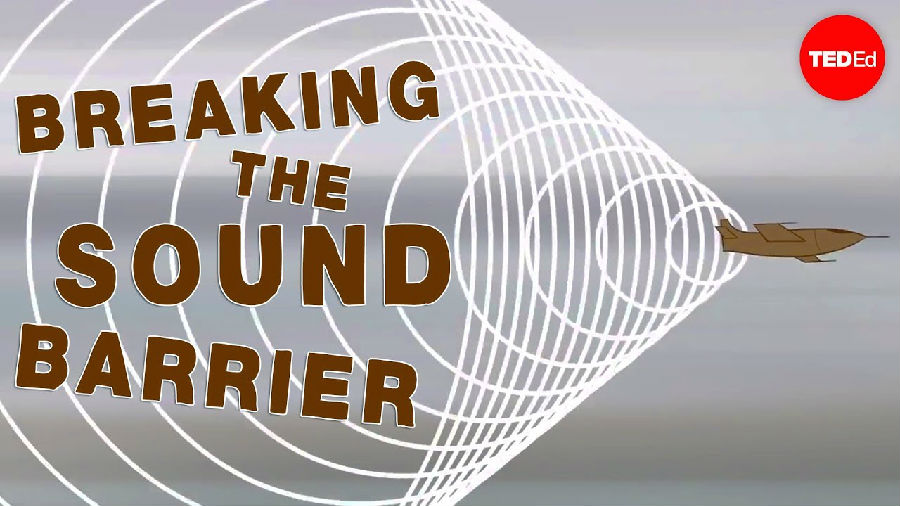(单词翻译:单击)
Humans have been fascinated with speed for ages.
人类已经痴迷于速度很多年了。
The history of human progress is one of ever-increasing velocity,
人类的进步史就是一部不断加速的速度史,
and one of the most important achievements in this historical race was the breaking of the sound barrier.
而其中最重要的成就之一就是突破音障。
Not long after the first successful airplane flights,
飞机成功试飞后不久,
pilots were eager to push their planes to go faster and faster.
飞行员们越来越追求将飞机的速度提高。
But as they did so, increased turbulence and large forces on the plane prevented them from accelerating further.
然而,剧烈的颠簸和巨大的阻力阻止了他们前行的脚步。
Some tried to circumvent the problem through risky dives, often with tragic results.
其中一些飞行员尝试规避高速飞行的风险,但结果常常是悲剧性的。
Finally, in 1947, design improvements, such as a movable horizontal stabilizer,
1947年,飞行器设计水准得到了提高,可调水平尾翼,
the all-moving tail, allowed an American military pilot named Chuck Yeager to fly the Bell X-1 aircraft at 1127 km/h,
又叫全动尾翼的出现,使一名名叫查克·叶格的美国空军飞行员驾驶X-1试验机的飞行速度达到1127千米/秒,
becoming the first person to break the sound barrier and travel faster than the speed of sound.
成为第一个突破音障,飞得比声音还快的人。
The Bell X-1 was the first of many supersonic aircraft to follow, with later designs reaching speeds over Mach 3.
X-1试验机是许多超音速飞机模仿的对象,之后有些飞机的航速甚至能突破3马赫。
Aircraft traveling at supersonic speed create a shock wave with a thunder-like noise known as a sonic boom,
飞机在超音速飞行时会产生冲击波,像雷鸣一样的声音,就是我们熟知的音爆,
which can cause distress to people and animals below or even damage buildings.
音爆会危害附近的人畜,甚至伤及周边建筑物。
For this reason, scientists around the world have been looking at sonic booms,
因此全世界的科学家们开始研究音爆,
trying to predict their path in the atmosphere, where they will land, and how loud they will be.
试图阻止其在大气中传播,研究它的响度以及何时停止。
To better understand how scientists study sonic booms, let's start with some basics of sound.
为了更好的理解科学家研究音爆,我们拿一些最基本的声音举例子。
Imagine throwing a small stone in a still pond. What do you see?
想象往平静的池塘扔小石子。看到了什么?
The stone causes waves to travel in the water at the same speed in every direction.
小石子引发的波浪在水中传播,所有方向的速度都一样。
These circles that keep growing in radius are called wave fronts.
这些半径持续扩大的圆圈叫做波阵面。
Similarly, even though we cannot see it,
同样,虽然我们看不见,
a stationary sound source, like a home stereo, creates sound waves traveling outward.
一个像家庭音响那样的固定声源在制造向外的声波。
The speed of the waves depends on factors like the altitude and temperature of the air they move through.
波向外传播的速度取决于海拔、气温等因素。
At sea level, sound travels at about 1225 km/h.
在海平面高度,音速约为1225千米/秒。
But instead of circles on a two-dimensional surface, the wave fronts are now concentric spheres,
与二维位表面上的圆圈不同,波阵面是同心球面,
with the sound traveling along rays perpendicular to these waves.
声音沿射线传播,垂直于波阵面。
Now imagine a moving sound source, such as a train whistle.
想象一个移动声源,比如火车汽笛。

As the source keeps moving in a certain direction,
持续朝同一方向移动,
the successive waves in front of it will become bunched closer together.
声源前方的波会聚拢。
This greater wave frequency is the cause of the famous Doppler effect, where approaching objects sound higher pitched.
增大的波频便引发了著名的多普勒效应,接近观测者的物体声调会变高。
But as long as the source is moving slower than the sound waves themselves, they will remain nested within each other.
但只要声源移动的速度比声波传播的速度慢,他们就会保持相互嵌套的状态不变。
It's when an object goes supersonic, moving faster than the sound it makes, that the picture changes dramatically.
只有当物体以超音速移动,比它自己发出的声音还快的时候,波的图像才会发生巨大变化。
As it overtakes sound waves it has emitted,
当它超越了自己先前发射的声波,
while generating new ones from its current position, the waves are forced together, forming a Mach cone.
同时又生成了新的声波,波们就被迫挤在一起了,形成了马赫锥。
No sound is heard as it approaches an observer because the object is traveling faster than the sound it produces.
当它靠近时,观测者听不到任何声音,因为物体比它自己制造的声音还快。
Only after the object has passed will the observer hear the sonic boom.
只有物体超越观测者之后,观测者才能听见音爆。
Where the Mach cone meets the ground, it forms a hyperbola,
马赫锥接触地面形成一条双曲线,
leaving a trail known as the boom carpet as it travels forward.
当它前行时留下一条轨迹叫做超音速爆音区。
This makes it possible to determine the area affected by a sonic boom.
这可以用来划分受音爆影响的区域。
What about figuring out how strong a sonic boom will be?
那要如何计算音爆的强度呢?
This involves solving the famous Navier-Stokes equations to find the variation of pressure in the air
可以通过求解著名的纳维-斯托克斯方程来找寻空气中气压的变化
due to the supersonic aircraft flying through it.
因为超音速飞机是在空气中飞行的。
This results in the pressure signature known as the N-wave.
由此导致了名叫N波的压力场特征。
What does this shape mean?
这个形状表示什么?
Well, the sonic boom occurs when there is a sudden change in pressure, and the N-wave involves two booms:
音爆的出现是由于气压骤变,而N波包括两个爆炸:
one for the initial pressure rise at the aircraft's nose,
一个在机头气压骤升时,
and another for when the tail passes, and the pressure suddenly returns to normal.
另一个在机尾越过马赫锥时,气压瞬间恢复正常。
This causes a double boom, but it is usually heard as a single boom by human ears.
这导致了两次爆炸,但人类通常只听得到一声爆炸。
In practice, computer models using these principles
飞行中,电脑模型利用这个原理
can often predict the location and intensity of sonic booms for given atmospheric conditions and flight trajectories,
以及提供的航行轨道和空气数据,常能预测音爆的位置和强度,
and there is ongoing research to mitigate their effects.
关于减弱音爆的研究也正在进行。
In the meantime, supersonic flight over land remains prohibited.
与此同时,超音速飞机仍不允许飞越土地上空。
So, are sonic booms a recent creation? Not exactly.
所以,音爆是近期的发明吗?不是。
While we try to find ways to silence them, a few other animals have been using sonic booms to their advantage.
当我们还在找寻降噪的途径时,很多动物们已经在利用音爆了。
The gigantic Diplodocus may have been capable of cracking its tail faster than sound, at over 1200 km/h, possibly to deter predators.
巨大的梁龙似乎能让它的尾巴通过敲击达到1200千米/秒的速度来威慑捕食者。
Some types of shrimp can also create a similar shock wave underwater,
某些种类的虾也能在水下制造相似的冲击波,
stunning or even killing pray at a distance with just a snap of their oversized claw.
只需弹一下它巨大的钳子就能远距离惊吓甚至杀死被食者。
So while we humans have made great progress in our relentless pursuit of speed, it turns out that nature was there first.
所以当人类在对速度不懈的追求中取得了重大进步时,却发现大自然早已先行一步。


